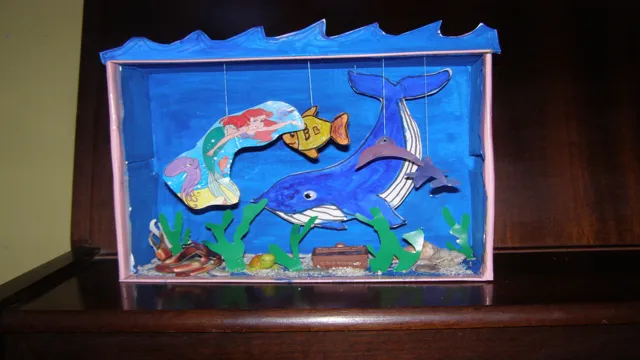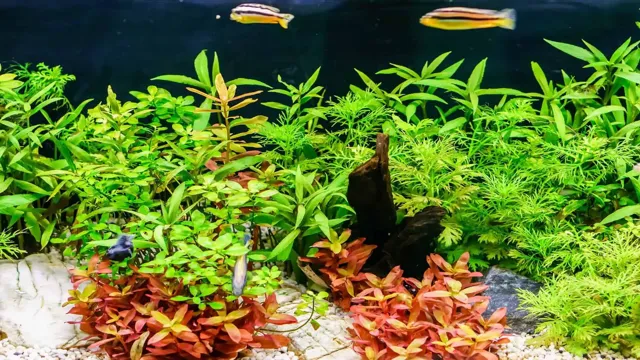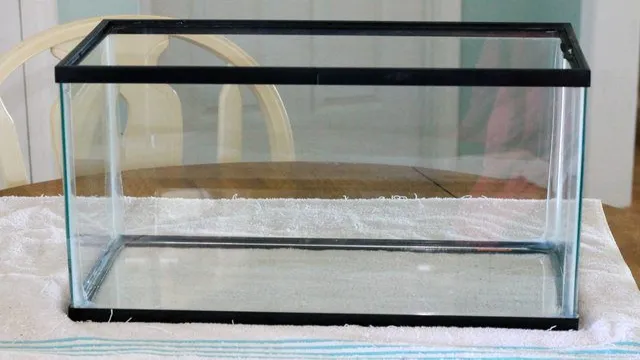Have you ever wanted to create an aquarium but didn’t know where to start? Maybe you don’t have enough space for a large tank, or perhaps buying one is too expensive. Well, fear not! You can make a small aquarium with just a shoe box and a few simple supplies. Not only is it a fun and cost-effective DIY project, but it also creates a beautiful and calming addition to any space.
So, put on your creative hat and let’s dive into how to make an aquarium with a shoe box.
Materials Needed
If you’re interested in creating an aquarium but don’t want to spend a lot of money on equipment, you can use a shoe box! To begin, gather your materials: a shoe box, clear plastic wrap, scissors, tape, and blue and green construction paper. Then, take your shoe box and cut out a rectangular hole on the top lid. Cover the hole with plastic wrap and secure it with tape.
This will allow light to enter the aquarium. Next, cut out fish shapes from the blue and green construction paper. Once you have a few different fish shapes, tape them to the bottom of the shoe box.
Finally, fill the box with water and voila – you have your very own aquarium in a shoe box! Remember to change the water every few days to keep your fish healthy. This is a fun and affordable DIY project that can bring joy to anyone interested in marine life. So why not give it a try?
Shoe box
If you’re looking to upcycle a shoe box into a craft project, then the first thing you’ll need is the box itself. Additionally, there are a few other materials that can be helpful in creating a personalized and unique project. Firstly, consider the type of paint or markers you want to use on the box.
Acrylic paint works well on cardboard surfaces and is widely available in arts and crafts stores. You may also want to consider adding embellishments, such as glitter, stickers, or ribbon, to enhance the box’s appearance. To attach these items, you’ll need glue or double-sided tape.
Another useful tool is a pair of scissors or a craft knife, which can be used to cut the box into different shapes or designs. With these materials in hand, the possibilities for creative shoe box projects are nearly endless!

Scissors
When it comes to creating crafts or cutting paper, scissors are an essential tool. But what materials are needed to make scissors? The answer to that question goes back centuries ago to the origins of scissors. The earliest scissors were made from bronze or iron, using simple tools to shape them.
Nowadays, most scissors are made from stainless steel, which is a durable and corrosion-resistant material. The handle of the scissors could be made from plastic, rubber, or wood, depending on the manufacturer’s preference. In some cases, scissors may have additional features such as a comfortable grip, adjustable blades, or even a serrated edge for cutting thicker materials.
The right combination of materials is crucial for scissors’ performance, ensuring that they are sharp, precise, and long-lasting. So, the next time you pick up a pair of scissors, take a moment to appreciate the craftsmanship and materials that went into making them.
Clear plastic wrap
Clear plastic wrap is a indispensable material to have in your household for many reasons. Whether you’re packing up leftovers, storing food in the fridge, or wrapping delicate items for transport, this versatile material is a true lifesaver. The basic materials needed for clear plastic wrap include the wrap itself, a dispenser to hold and cut the wrap, and a clean surface to work on.
When selecting clear plastic wrap, it’s important to pick a high-quality product that is durable and will cling tightly to your items. Look for a wrap that is thick enough to protect your food and has a reliable cling. Additionally, having a dispenser will make using clear plastic wrap much easier and efficient.
Lastly, a clean and flat surface to work on ensures that your wrap is applied evenly and securely. With these simple materials, you’ll be able to make the most out of your clear plastic wrap and have a variety of uses at your fingertips.
Tape
If you’re planning a project that involves tape, there are a few essential materials you’ll need to get started. First and foremost, you’ll need the tape itself! There are many different types of tape available, each with their own unique qualities and uses. For example, masking tape is commonly used in painting projects, while duct tape is known for its durability and strength.
Double-sided tape is perfect for attaching two surfaces together, while electrical tape is designed specifically for use with electrical wiring. Depending on your project, you may need to use one or more types of tape, so it’s important to choose the right tape for the job. Additionally, you may want to have a pair of scissors or a utility knife on hand to cut the tape to the desired length.
Finally, if you’re using a sticky or adhesive tape, you may want to have some rubbing alcohol or a specialized tape remover on hand to clean up any residue once your project is complete. With these materials in hand, you’ll be ready to tackle any tape-based project with confidence! (See Also: How to Create a Cheap Iwagumi Aquarium: A Step-by-Step Guide)
Blue food coloring
Blue food coloring is an essential ingredient in many recipes and is a great way to add vibrancy and excitement to any dish. To use blue food coloring effectively, you will need a few basic materials. Firstly, you will need the blue food coloring itself, which can be found at most grocery stores.
It is available in either liquid or gel form, so choose whichever is most convenient for your recipe. Additionally, you will need a small bowl or cup to mix the food coloring in, as well as a spoon for stirring. Finally, make sure to use disposable gloves to prevent staining your skin while handling the food coloring.
With these simple materials, you are ready to add some color to your culinary creations! Whether you’re baking a cake, decorating cupcakes, or adding some fun to your drinks, blue food coloring is sure to impress your guests and make your dish stand out. So let your creativity run wild and experiment with new and exciting ways to use blue food coloring in your cooking today!
Steps to Make Aquarium
If you’re looking for a unique project to take on, consider making an aquarium out of a shoe box! It’s a fun and creative way to bring aquatic life into your own home. First, make sure you choose a sturdy shoe box that can hold water without leaking. Then, cut a piece of clear plastic to fit the size of the box and glue it to the inside edges.
Fill the bottom with aquarium gravel and add water. Next, choose some aquatic plants and decorations to liven up the space. You can even add a small filter and heater to keep the water clean and at the right temperature for any fish you may want to add.
It’s important to research and choose fish that are appropriate for the size of your tank, as a small shoe box aquarium won’t be able to house many fish. Enjoy your new mini-aquarium and watch as your fish swim and play in their new home!
Step One: Cut the lid off the shoe box
If you’re looking to add a unique touch to your home decor, making an aquarium out of a shoebox is a fun and creative project to consider. The first step in creating your shoebox aquarium is to cut the lid off the box, making sure to do so cleanly and without any jagged edges. You can use a pair of scissors or a craft knife to achieve a precise cut.
Once the lid is removed, you’ll have the base of your aquarium ready for the next steps. It’s important to note that you may want to reinforce the sides and bottom of the shoebox with duct tape or another sturdy material to ensure that it can hold water without leaking. With the first step complete, you’re well on your way to creating a small and charming aquarium that will add plenty of character to your space.
Step Two: Cut the clear plastic wrap to fit inside the box
When it comes to making your very own aquarium, it’s important to take things step by step. Once you have your box ready, it’s time to move onto step two: cutting the clear plastic wrap to fit inside. This is an important step that ensures your aquarium stays leak-proof and secure.
Take care to measure the dimensions of your box precisely, so that the plastic wrap fits snugly. You may need to do some careful trimming to get the perfect fit, but the effort is well worth it. Think of it like wrapping a present – you want everything to look neat and tidy, without any awkward bulges or gaps.
So take your time, and don’t rush this crucial step. Before you move on to the next part of the process, you want to make sure the plastic wrap is completely secure. With this step completed, you’re well on your way to creating a beautiful and functional aquarium.
Step Three: Tape the plastic wrap to the sides and bottom of the box
When creating an aquarium at home, one important step is to tape the plastic wrap to the sides and bottom of the box. This helps to create a barrier between the water and the cardboard box, so that it doesn’t become damaged or leak. To start, make sure that the plastic wrap is large enough to cover the entire inside of the box, with plenty of excess at the edges.
Then, carefully press the plastic wrap against the sides and bottom of the box, making sure that there are no air bubbles or gaps. Next, use heavy-duty tape to secure the plastic wrap in place, starting at the corners and working your way around the edges. You may need to use multiple layers of tape to ensure that the plastic is firmly attached.
By taking the time to do this step properly, you can help ensure that your homemade aquarium is both sturdy and leak-proof, keeping your fish and other aquatic creatures safe and happy.
Step Four: Add blue food coloring to the water
Adding blue food coloring to the water is the fourth and final step in creating an aquarium that looks like a real underwater habitat. This step is crucial because it gives the water its blue hue, imitating the natural color of water bodies. Once you have filled the aquarium with water and added the rocks, plants, and plastic aquatic creatures, it’s time to mix blue food coloring in the water. (See Also: How to Clean Python Aquarium Hose: The Ultimate Guide for Sparkling Results)
You can start by adding 1-2 drops of blue food coloring and gradually increase the amount until you achieve your desired shade of blue. The blue color provides a perfect backdrop for the plants, rocks, and toys, making everything look more natural and aesthetically pleasing. Moreover, it helps to create an illusion of depth, just like in real aquatic systems.
Adding the food coloring might seem like a small detail, but it can make all the difference in how your aquarium looks and feels. So, don’t skip this vital step and enjoy your newly created aquatic world!
Step Five: Fill the box with water and place plastic fish inside
Making an aquarium is a fun activity that can be enjoyed by individuals of all ages. Once you have set up the essentials, it’s time to fill the box with water and add some plastic fish inside. But wait! Before you do that, make sure that the water is properly conditioned and heated to the right temperature.
This will ensure that your fish will thrive and live happily in their new home. When picking plastic fish, consider their size and color to make sure they blend well with the environment you created. Adding some plants and decorations will enhance the beauty of the aquarium and provide a more natural habitat for the fish.
And don’t forget to feed your fish regularly and keep their tank clean to maintain their health. With all these in mind, you can now enjoy the sight of your very own aquarium and the vibrant marine life it holds.
Tips for Decorating
Aquariums make beautiful and engaging additions to any home, but not everyone has the space or budget for a large, traditional aquarium. However, with a little creativity and a shoe box, you can create your own miniature aquarium that will bring life and vibrancy to any room. Start by lining the inside of the shoe box with a sturdy plastic sheet.
Fill the box with a few inches of sand or gravel, and add some small plants or artificial coral for decoration. Next, add water to the box, being sure not to overfill it. Finally, add some small fish or shrimp to your little tank, and watch as your new aquarium comes to life.
With some patience and a little imagination, anyone can create a stunning aquarium that fits their budget and space requirements, and the best part is, you can change it up whenever you like!
Add rocks or shells to the bottom of the aquarium
When it comes to decorating your aquarium, adding rocks or shells to the bottom can be a great way to enhance the overall look and feel of the tank. Not only do they add aesthetic appeal, but they also provide hiding places for your fish and help to create a more natural-looking environment. It’s important to choose rocks or shells that are safe for your aquarium, as some may contain harmful chemicals or pollutants.
You can purchase these items at your local pet supply store or collect them from natural sources, but make sure to clean them thoroughly before placing them in your tank. Additionally, be mindful of the size and number of rocks or shells you add, as overcrowding can lead to problems with water filtration and maintenance. So, if you’re looking to spruce up your aquarium, consider adding some rocks or shells to the bottom for a unique and beautiful touch.
Use stickers to create seaweed or fish
Stickers are not just for decorating notebooks and laptops, they can also be a great addition to aquariums! If you want to create an underwater theme in your fish tank, consider using stickers to create seaweed or fish. These stickers are readily available in most craft stores and designed to be waterproof and safe for aquariums. To make your aquarium look more realistic, place the stickers in such a way that they mimic the natural environment of the fish.
For example, stick the seaweed sticker on the sides of the tank and create a grouping that gives it a more organic look. You can also get creative by using different colors and shapes to create an interesting underwater landscape. Stickers are a fun and affordable way to add a touch of personality to your aquarium.
So why not give it a try? Your fish will love their colorful new home!
Add a background to the back of the box
Adding a background to the back of your box can add a whole new dimension to its appearance. You can opt for a patterned paper or solid colored paper, depending on the item that you’re putting inside. Solid colored paper can give your box a minimalistic, sleek look while patterned paper can add a touch of personality and fun.
When choosing a pattern, make sure it complements the item inside and doesn’t clash. A simple tip is to pick a pattern that is either smaller or larger than the item you’re putting inside. This creates an interesting visual contrast.
Don’t be afraid to experiment with colors and textures as well. A textured, matte paper can add depth while a shiny paper can make your box look more glamorous. With these simple tips, you can transform your plain box into a standout piece. (See Also: How to Get Rid of Blue Green Algae Aquarium: Effective Tips and Tricks)
Conclusion
In conclusion, turning a humble shoe box into an aquarium is a fun and inventive way to spiff up your living space. With just a few simple materials and a bit of creativity, you can create a underwater oasis that will have all your friends and family hooked. So go ahead and dive in – with a shoe box as your starting block, the ocean’s the limit!”
Creating an aquarium with a shoe box is a fun and easy way to teach kids about aquatic life.
When creating an aquarium with a shoe box, the decoration is an important element to consider. Not only does it make the shoe box aquarium look more appealing, but it also enhances the learning experience for kids. One tip for decorating is to use colorful paper or paint to create a underwater theme.
Kids can draw fishes, sea plants, and other aquatic creatures to glue onto the interior of the box. Another decorating idea is to add colorful pebbles and shells to the bottom of the aquarium. This can make the aquarium look more realistic and give the fish a place to hide and play.
It is also important to be creative while decorating as it can help to stimulate kids’ imagination and interest in aquatic life. Don’t be afraid to add some personal touch such as adding an island or a mini-shipwreck. By decorating creatively, kids can learn about the environment, the life cycle of aquatic creatures, and can have a chance to develop their own creativity.
Decorating a shoe box aquarium can give both the parents and kids a great opportunity to learn and bond together while creating something fun and fascinating.
FAQs
What materials do I need to make an aquarium out of a shoe box?
You will need a shoe box, clear plastic wrap, blue food coloring, rocks or sand, plastic plants, and plastic fish.
Can I use a different type of box instead of a shoe box?
Yes, you can use any type of box as long as it is sturdy and can hold water.
How do I create a water effect for my shoe box aquarium?
Fill the shoe box with water and then add a few drops of blue food coloring. This will give the water a blue tint and make it look like a real aquarium.
Do I need to seal the box to prevent leaks?
Yes, it is important to seal the box with clear plastic wrap and tape to prevent any leaks.
Can I use real fish instead of plastic ones?
No, it is not recommended to use real fish as the shoe box aquarium is too small and does not have proper filtration or aeration for the fish to survive.
How do I make the plastic plants look more realistic?
You can glue small rocks or sand to the bottom of the plastic plant bases to make them look like they are planted in the aquarium.
How often do I need to change the water in my shoe box aquarium?
It is recommended to change the water every few days or as needed to keep the water clean and clear.







